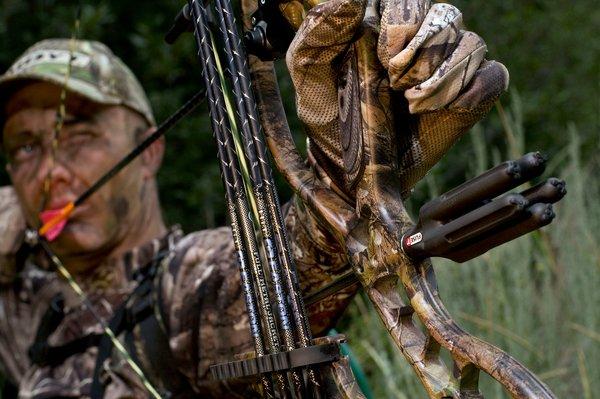It Takes Practice to Kill Big Deer.

Then he's there, broadside, in chip-shot range. You raise your bow, hit full draw and watch the arrow flash ahead, right over the deer's back. The broadhead slams into a tree with a loud crack, and the buck scrambles out of sight. How in the world did you miss such an easy shot?
Hours of shooting practice, bow tuning and scouting. Treestands hung. Trail cameras checked. Hundreds of dollars spent on gear. All put together to produce one vital moment of action. A vital moment you just completely blew. Yes indeed, buck fever is one of bowhunting's worst experiences. No one is immune to it, and there are no instant cures. But instant is the key word.
It's OK to get excited. That's why we hunt and shoot a bow. But we must take control before the excitement progresses to a point of ruining things. To do this, we have to have a plan to become mentally stronger.
If you've suffered buck fever, or target panic as many call it, here are five things you can do to get your shooting back on track.
1. My Name's Joe Hunter, and I Have a Problem
The first step in conquering buck fever, and I know you've heard this before, is to admit there's a problem. Tell yourself and your buddies, "Hey, I get pretty excited on game, and it affects my shooting." If they laugh or call you a sissy, who cares? Don't be ashamed of buck fever. The problem occurs because you love bowhunting and because making a good shot is of such importance to you that it makes you overly excited and nervous. That's not a bad thing. Only caring too much about something often foils our concentration. And this is the part we need to straighten out.
2. Autopilot Your Shot Sequence
Review the basic steps behind a good shot. This will properly structure your mind so it approaches shooting more systematically. This is where practicing a specific shot sequence becomes important, so it becomes second nature over time (it usually takes 30 days or more). The sequence can be as simple as seven steps, or it can be as long as 16, but make it as detailed as you can without being too complicated to execute.
My personal shot sequence goes like this: 1. Nock arrow 2. Set my stance 3. Hook up release 4. Raise bow to level and set bow-hand position 5. Draw bow (slowly and without raising bow much if any); inhale a deep breath during draw 6. Find my anchor; center pin in peep 7. Sight calibration with target; relax bow hand 8. Exhale a half breath; establish aim 9. Direct my mind to shot activation; expand back muscles until the shot breaks by surprise. 10. Check conclusion / back tension; hand should lightly touch my ear.
When practicing, I routinely step my way through the sequence, never going out of order or skipping a step. I want my subconscious mind to be ultra clear as to how I want the shot to be processed. If it is, it will carry these steps out on auto-pilot, even if my conscious brain is bogged down with excitement and nervousness.
3. Talk it Through
While the subconscious mind can handle multiple tasks at once, the conscious mind can only do one thing well at a given time. If this is the case, what should our conscious mind be thinking about when shooting a bow?
Some archery coaches believe it should be solely on aiming, while others say it should be on the process of using our body's muscles to activate the shot, since the subconscious is fully capable of keeping the sight pin on the target (aiming) without any conscious action.
Joel Turner, who coaches archers across the nation with a program called Ironmind Archery Systems (contact him at [email protected]), believes in this kind of subconscious aiming. But he also believes in the power of word association and speech for keeping the conscious mind totally occupied and focused, so it can assist the body in triggering the shot without interruption. He believes conscious direction is needed for the mind to really concentrate, particularly under pressure.
This is why he suggests using an internal mantra to keep the shot active and to keep the conscious mind busy. A good example would be the phrase "keep pulling...keep pulling...keep pulling."
"When it is said in a smooth, revolving fashion, it gives the conscious mind guidance as to exactly how to pull and at what rate," Turner said. "When the conscious mind is totally engulfed in the shot activation, buck fever or target panic is non-existent. The mantra is just a tool to get you to concentrate. "
4. Shoot by Surprise
No longer should we "control" when the shot is fired, but on consciously focusing on the muscles needed to execute the shot. This will prevent the visual cue of seeing our sight pin close to the deer's chest from short-circuiting our brains, keeping us more focused on the mechanics of the shot and not the sight picture itself.
This is where "back tension" comes into play. Every release aid can be shot totally by subconscious action, but only through proper release fit / adjustment and through the "tightening" or "pulling" of our draw-side back muscles or arm / elbow unit.
If you're like most bowhunters and shoot a wrist-strap release, adjust it so the trigger bisects the first crease (or slightly above) your index finger while you're at full draw. This will allow you to point your finger downward, so you can curl the trigger like a hook. At full draw, you should be able to rotate the right shoulder blade in toward the other and feel the pressure of the bow's weight in your back rhomboid muscle. This is the movement you'll execute to trigger the shot.
Now with an arrow nocked and the bow drawn, standing only 5 yards from the target butt, pull with your draw-side shoulder blade, allowing your forearm, hand and finger hook to take in the pressure of the trigger. The shot should come in about 4 to 5 seconds. Play with the trigger tension setting on your release aid until you get it right.
Once you engrain your shot sequence and the muscle memory required to smoothly get through a surprise release, the next step is the most important, according to Turner. This step involves separating the shot into two distinct parts: aiming and then the actual shot activation. These two steps should occupy your mind every time you prepare to shoot.
"You must have a plan before you step up to the line or shoot at a big buck," Turner said. "If not, then you're just hoping for good results instead of setting yourself up for a good result."
Once you establish your aim, switch all your conscious thinking to using your mantra until the shot breaks. If the pressure is really on, Turner suggests saying the mantra with even more aggression in order to keep the mind from losing focus. He used the analogy of weightlifters and how they talk to themselves to pump more weight. They aren't all nicey, nicey about it. The same goes for shooting under pressure. Get bold when telling yourself to "keep pulling..." until the shot breaks, all by surprise.
After learning this shooting plan, it's important that you go out and test it under stress. If you aren't mentally centered halfway through the draw, then you must let down. Don't shoot a bad shot. If so, you'll be sliding back into your old ways of shooting and reinforcing bad habits. Stay disciplined and shoot every arrow with 100 percent concentration.
If you ignore buck fever, it will almost surely stop you from enjoying the sport, if it hasn't already. My advice is to try the steps outlined in this article and stop it before it becomes a problem. Simply trust the training, and soon this dreaded affliction will be a thing of the past.
Click here for more deer hunting stories and how-to's.
Check us out on Facebook.
Editor's note: The was originally published on July 16, 2013.








